Mastering the turning point in coffee roasting is essential for achieving the perfect flavor and aroma. This key moment occurs within the first minute when the bean temperature aligns with the roaster temperature. Getting it right balances acidity and sweetness, enhancing your final roast's complexity. If you wait too long or rush the process, you risk compromising the taste. Utilize tools like infrared sensors for precise monitoring, ensuring you capture every subtle temperature change. Understanding these dynamics can transform your roasting experience, setting you on a path to consistently exceptional coffee. There's much more to explore on this journey!
Key Takeaways
- The turning point marks a critical moment in roasting, balancing acidity and sweetness for complex flavor development.
- High-density beans have distinct turning points, influencing roasting strategies for optimal flavor extraction.
- Consistent monitoring of the turning point ensures precise heat management and consistency across batches.
- Advanced sensors, like infrared and IBTS, provide real-time temperature insights for accurate roasting adjustments.
- Understanding drop temperature is essential to avoid scorching and enhance the final coffee's flavor profile.
Understanding the Turning Point
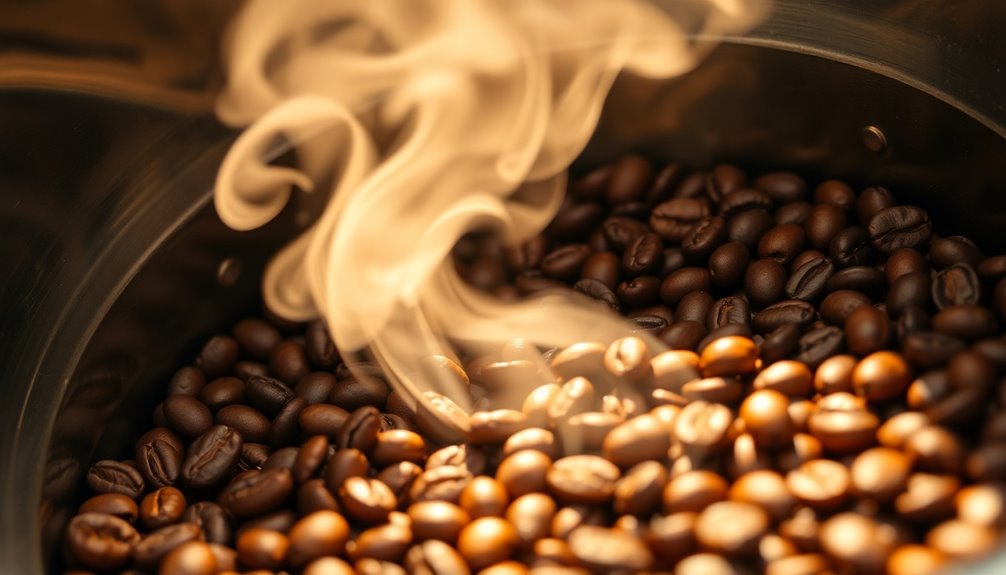
Understanding the turning point in coffee roasting is important because it greatly influences the flavor profile of your beans. This moment occurs within the first minute when the temperature of your beans aligns with that of the roaster.
It's a significant phase for flavor development and indicates your heat management is on point. Before this turning point, temperature readings can be misleading due to the cooling effect of cold beans on the probe.
You'll only see accurate data when the rate of rise (RoR) shows equilibrium. High-density beans may display faster drying phases, leading to higher turning point temperatures, vital for ideal roasting.
This phase also offers a chance to make necessary adjustments before reaching the dry end of roasting.
Ideal Turning Point Parameters

When you're roasting coffee, timing and temperature balance are essential at the turning point.
Different bean types can also affect these parameters, so you'll need to adjust your approach accordingly.
Keeping a close eye on these factors will help you achieve that perfect roast.
Timing and Temperature Balance
Achieving the ideal turning point in coffee roasting is vital for developing the best flavor profiles. This turning point usually happens within the first minute, where your temperature reading aligns with the beans for maximum flavor development.
If your turning point occurs too late, it might mean there's insufficient thermal energy, leading to a compromised roast quality. On the other hand, an early turning point risks overheating and scorching the beans, which negatively impacts the final taste.
Consistently monitoring this turning point is essential, as it sets the trajectory of your roasting process and influences the final roast level.
Bean Type Variability
The turning point of coffee roasting varies considerably depending on the type of bean used. Higher density coffee beans, like Robusta, usually have a turning point closer to 200°C due to their moisture content and heat retention.
In contrast, Arabica beans typically range between 190°C to 200°C. Lightly processed beans often reveal an earlier turning point, while dark or oily beans experience a delay because of their lower density and different heat absorption.
The rate of rise (RoR) before the turning point also differs; lower-density beans heat up faster than their denser counterparts.
Misinterpretations of Turning Point
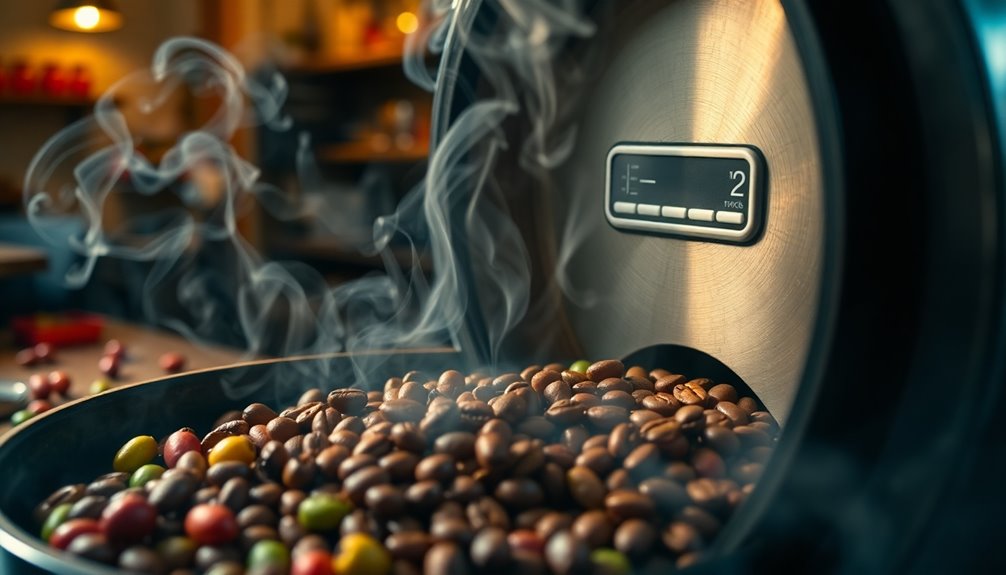
Understanding the turning point in coffee roasting is essential, yet many misinterpret its significance.
It's not when beans reach their ideal roasting temperature; rather, it's the moment when the temperatures of the beans and the roaster equilibrate. This vital phase can be misleading, as temperature probes might show inaccurate readings due to the initial cooling effect of room temperature beans.
You might even mistake the rapid increase in bean temperature and a subsequent drop in probe temperature as stability. It's important to recognize that data collected before the turning point often doesn't reflect the true heating rate.
To avoid these pitfalls, consider using more precise measurement tools, like infrared sensors, for tracking real-time roasting dynamics effectively.
Real Rate of Rise Dynamics
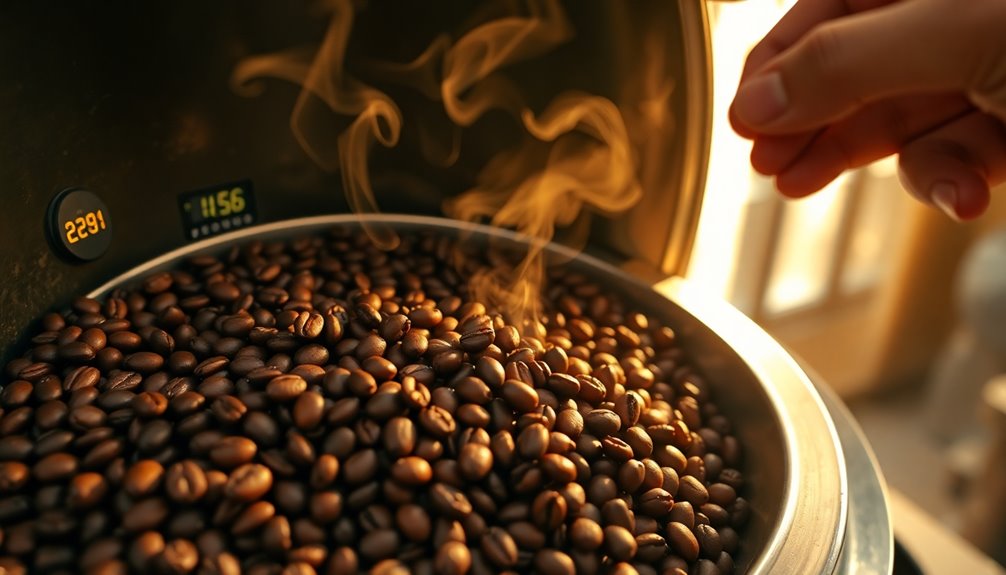
When you're roasting coffee, the Real Rate of Rise (RoR) is essential for understanding how quickly the beans are heating up.
Accurate measurement techniques, like using infrared sensors, can help you capture this rapid temperature increase and avoid misleading data.
Rapid Temperature Increase
As you add coffee beans to the roaster, a rapid temperature increase occurs, marking the fastest heating phase within the first minute of roasting.
During this time, the beans quickly absorb heat, causing their temperature to rise sharply.
However, standard temperature probes often show a misleading drop initially due to the cooling effect of the cold beans, failing to accurately represent the real rate of rise (RoR).
Infrared sensors prove more effective in capturing this quick rise, offering clearer insights into temperature dynamics.
Understanding the real RoR before the turning point is essential, as it directly influences flavor development and the overall quality of your roasting process.
Make informed adjustments to guarantee a perfect roast every time.
Accurate Measurement Techniques
The rapid temperature increase during the first minute of roasting highlights the importance of accurate measurement techniques for capturing the real rate of rise (RoR) dynamics.
As you roast coffee, you need to understand how quickly the beans absorb heat, especially since the fastest heating rates occur right after they're dropped into the roaster.
Standard temperature probes often fail to capture this rapid rise accurately, leading to misleading data.
Instead, consider using infrared sensors, like those in the Aillio Bullet roaster with IBTS technology. These provide clearer insights into RoR during this critical phase.
Impact on Roast Quality
How essential is the real rate of rise (RoR) in determining roast quality? The speed at which your coffee beans heat before the turning point is critical for achieving the desired roast profile and flavor development.
- The crackling sound of beans releasing moisture
- The rich aroma wafting through the air
- The vibrant colors of roasted beans changing
- The satisfying texture of freshly roasted coffee
During the initial minute, RoR peaks, making it vital to monitor temperature precisely. Standard probes can mislead, but infrared sensors like those in the Aillio Bullet roaster offer accurate RoR readings. Additionally, understanding the mechanics of brewing can enhance your overall coffee experience and lead to a more refined taste.
The Significance of Drop Temperature
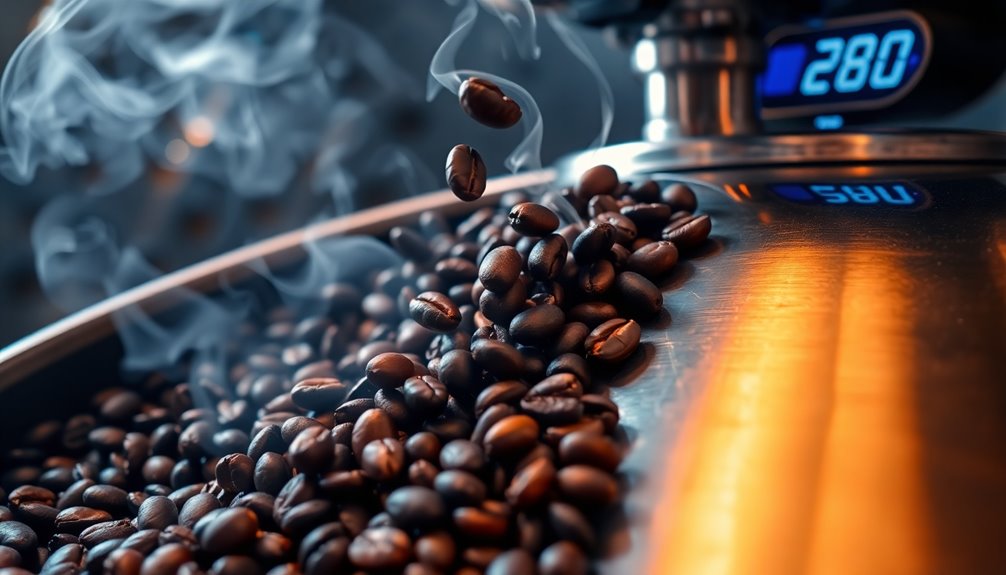
When you roast coffee, understanding drop temperature is essential because it greatly influences the overall quality of your brew.
Drop temperature is the point at which you add the beans to the roaster, and it plays a critical role in the pre-turning point phase of coffee roasting. A high drop temperature can scorch the beans, leading to astringency and poor flavor.
By monitoring drop temperature, you can achieve ideal roast quality, enhancing acidity, sweetness, and flavor notes. This relationship between drop temperature and the turning point helps you identify necessary adjustments during roasting, ensuring consistency across batches.
Grasping the significance of drop temperature allows you to refine your techniques for desired flavor profiles and elevate your coffee quality.
Flavor Development and Turning Point
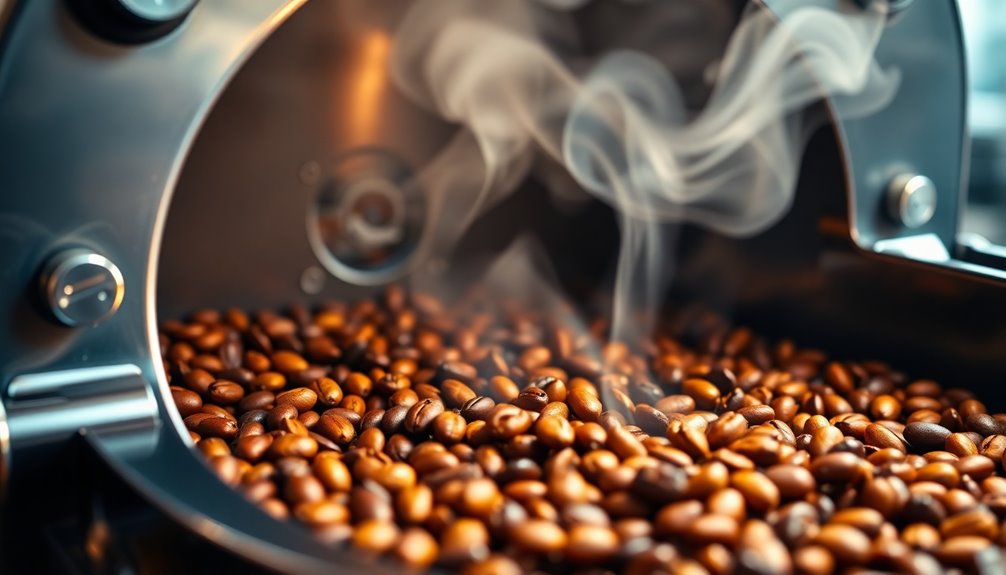
When you hit the turning point in coffee roasting, you're setting the stage for flavor development.
This essential moment affects the balance of acidity and sweetness in your brew, shaping the overall flavor profile.
Turning Point Significance
As the temperature of coffee beans begins to rise after an initial drop, the turning point becomes a pivotal moment in the roasting process that directly influences flavor development.
This stage, usually occurring within the first minute, helps you balance acidity and sweetness, shaping the final cup's character. By monitoring the turning point, you can achieve ideal flavor profiles tailored to different bean types and roasting machines.
- A rich, sweet caramel note
- Bold, vibrant acidity
- Hints of dark chocolate
- A lingering, smooth finish
Understanding the turning point's significance allows you to manage heat application and timing effectively, enhancing the complexity and richness of your coffee's flavor and aroma.
Flavor Profile Impact
Understanding how the turning point affects flavor development is essential for any coffee roaster. This moment, occurring within the first minute of roasting, marks a vital shift that greatly influences your coffee's flavor profile.
Properly managing the turning point balances acidity and sweetness, helping you create complex flavor notes in the final roast. If you're roasting high-density coffees, higher turning point temperatures can lead to a faster drying phase, which might enhance flavor characteristics if managed well.
By grasping the relationship between the turning point and subsequent roasting stages, you can fine-tune your process, ensuring consistency across batches and ultimately elevating the overall flavor profile of your coffee.
Mastering this aspect of roasting is key to achieving desired flavor outcomes.
Monitoring Roast Quality
Monitoring roast quality is essential for achieving the perfect flavor profile in your coffee. The turning point, which usually occurs within the first minute, is a critical moment.
Here's what to keep in mind:
- The subtle rise in temperature, signaling efficient heat transfer
- A late turning point indicating insufficient thermal energy
- An early turning point, hinting at potential scorching
- The rate of rise (RoR) providing insights into bean density
Tools for Precision Roasting
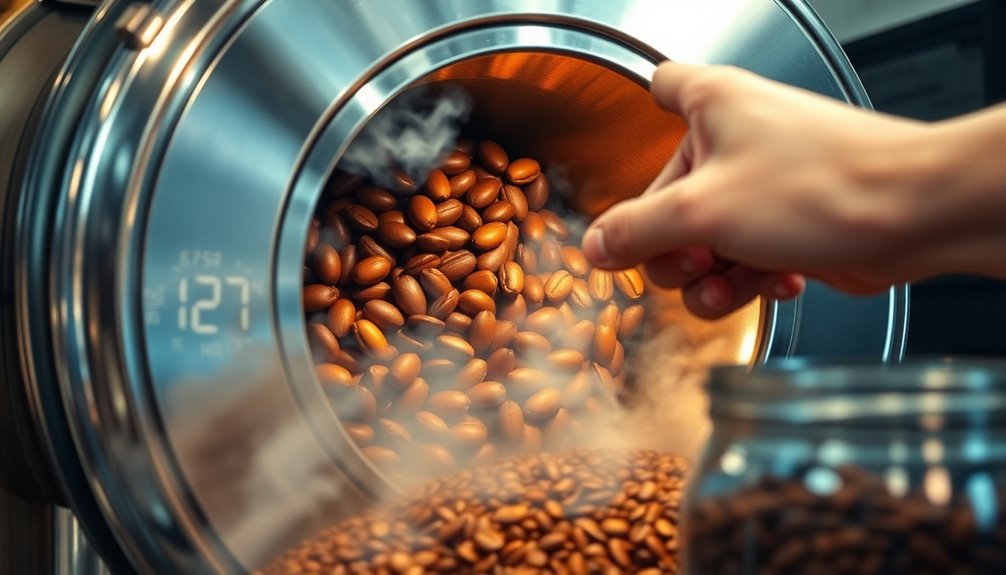
Precision roasting demands the right tools to achieve ideal results. Accurate temperature measurement is essential; infrared sensors capture rapid temperature changes that traditional probes might miss.
For instance, the Aillio Bullet roaster features an Integrated Bean Temperature Sensor (IBTS), allowing you to track real-time temperature fluctuations and monitor the rate of rise (RoR) effectively before the turning point.
Additionally, using a digital thermometer with a high response rate provides immediate feedback on bean temperatures, helping you make timely adjustments to avoid overheating or underdevelopment.
A well-calibrated roasting machine guarantees consistency, enabling you to replicate the turning point across multiple batches.
Finally, maintaining meticulous records of turning point data will enhance your learning and improve future flavor profiles.
Monitoring Roast Profiles
As you explore coffee roasting, tracking essential temperature milestones is vital for achieving the perfect flavor. Monitoring roast profiles allows you to pinpoint the turning point, where the rate of rise shifts from decreasing to increasing. This moment typically occurs within the first minute of roasting and sets your roast trajectory.
- The intense heat enveloping the beans
- The rich aromas beginning to emerge
- The dramatic color change as they darken
- The satisfying crack signaling flavor development
Utilizing advanced sensors, like infrared technology, enhances your ability to capture accurate data during this significant phase. Consistent monitoring guarantees you achieve desired flavor profiles and repeatability across multiple batches, making your roasting journey a delightful adventure. Additionally, understanding the importance of HEPA filtration can help you maintain a clean roasting environment, ensuring that external contaminants do not interfere with your coffee's flavor.
Enhancing Aroma and Taste
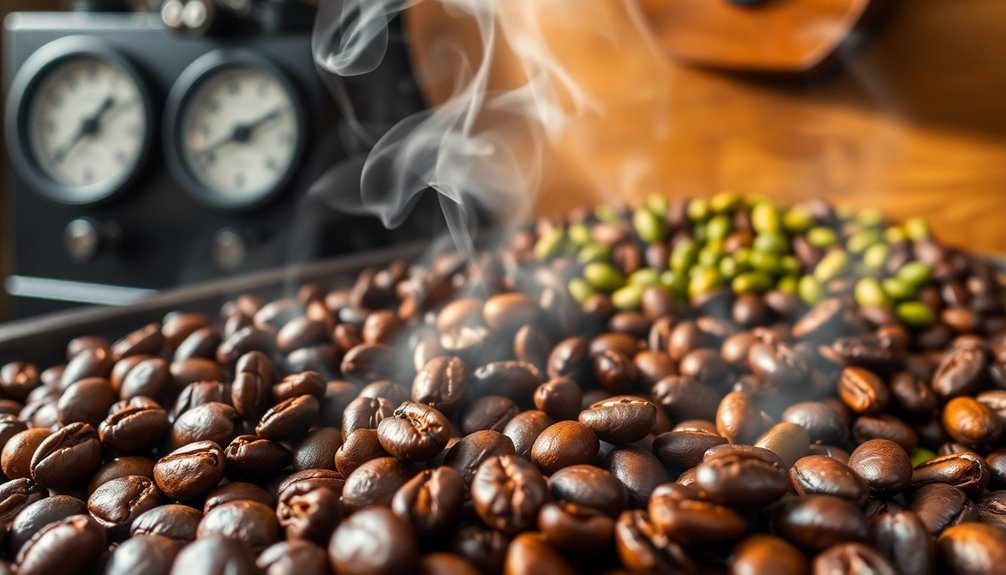
While achieving the perfect roast is essential for flavor, enhancing aroma and taste requires careful attention to the subtleties of the roasting process. The turning point plays a pivotal role in developing desirable aroma compounds, impacting acidity, sweetness, and overall flavor. Aim for an ideal turning point within the first minute for the best results. Additionally, a well-timed turning point can contribute to improved cognitive function, making your coffee not only flavorful but also beneficial for mental clarity.
| Aspect | Importance | Impact on Flavor |
|---|---|---|
| Turning Point | Critical for aroma | Balances flavors |
| Rate of Rise | Indicator of development | Guides roast progression |
| Bean Density | Affects turning point temp | Enhances complexity |
Monitoring these factors guarantees you avoid scorching, allowing those rich, complex flavors to shine through in your cup.
Continuous Learning in Roasting
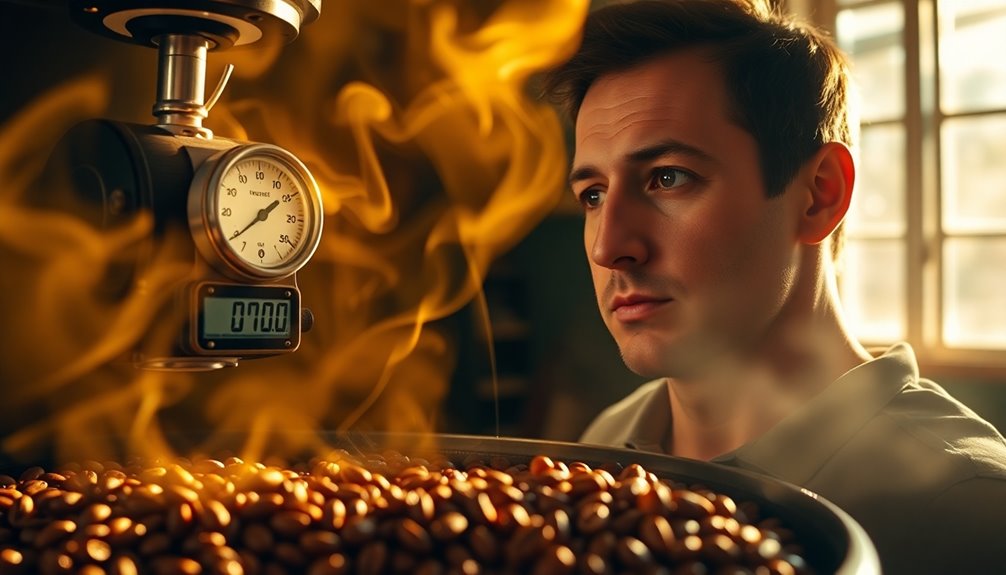
To master the art of coffee roasting, it's essential to embrace continuous learning, which not only deepens your understanding of the science behind the process but also enhances your skills.
By focusing on the turning point, you can reveal the full potential of flavor and aroma in your roasts.
- Engage with video tutorials and expert articles.
- Experiment with various roasting machines and bean types.
- Utilize advanced tools like infrared sensors to track temperature dynamics.
- Participate in community discussions to share insights and strategies.
As you learn from seasoned coffee roasters and adapt your techniques, you'll refine your approach and elevate your roasting game, ensuring every batch is a step toward perfection.
Frequently Asked Questions
What Is the Turning Point in Coffee Roasting?
The turning point in coffee roasting's the moment when your beans and the roaster hit temperature equilibrium, usually within the first minute.
This marks a significant shift in the roast profile, indicating that the beans are moving from cooling to heating.
It's vital to monitor this closely, as an early or late turning point can affect the roast quality.
Understanding it helps you make necessary adjustments for a consistent and flavorful batch.
How to Flavor Coffee When Roasting?
Flavored coffee can feel like a symphony of taste in your cup!
To flavor coffee while roasting, start by adding natural flavor enhancers or oils at specific stages of the process. Timing is everything; experiment with when you introduce these agents to achieve the perfect balance.
Monitor how the beans react to different origins and roast levels, ensuring the flavors harmonize without drowning out the coffee's natural characteristics.
Enjoy your flavorful journey!
What Is the Key Reaction for the Development of Roasted Coffee Flavour and Color?
The key reaction for developing roasted coffee flavor and color is the Maillard reaction, which kicks off around 300°F (150°C).
This process creates a range of complex flavors, giving your coffee those nutty and toasted notes.
As you roast, watch for caramelization starting at 320°F (160°C) to add sweetness and richness.
Each stage of these reactions plays an essential role in shaping the final taste and appearance of your brew.
Why Is Turning Important When Roasting?
Ever noticed how a slight change in timing can make or break your coffee experience?
That's why the turning point's essential when roasting. It signals the shift from heat absorption to flavor development, impacting your brew's acidity and sweetness.
If you monitor this moment closely, you'll achieve a consistent roast level, avoiding defects that could ruin your cup.
Conclusion
Mastering the turning point in coffee roasting isn’t just for professionals; it’s for anyone passionate about flavor. You might think perfecting your roast is too complicated, but with the right tools and knowledge, you can create a brew that excites your senses. Embrace the journey of learning and experimentation, and you’ll discover the joy of crafting coffee that truly resonates with you. Remember, every roast is an opportunity to reveal something extraordinary! As you refine your skills, you can explore perfect stovetop coffee techniques that enhance the richness of your brews. By understanding the intricacies of extraction and the impact of temperature, you’ll elevate your coffee experience to new heights. So, grab your favorite beans and get ready to unlock a world of flavors—every cup is a canvas waiting for your unique touch!










